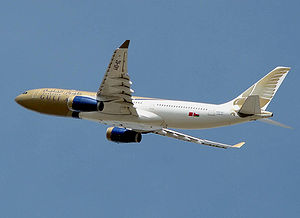 Image via Wikipedia
Image via Wikipedia
Related past reports on the missing plane
----------
Air France flight AF447
Spanish pilot tells of what he saw from his cockpit
05:55 AM Jun 05, 2009
FERNANDO DE NORONHA (Brazil) - Conflicting clues to the cause of the loss of an Air France jet and the 228 people on board emerged yesterday, deepening the mystery as the hunt for evidence intensified.
A Spanish pilot flying in the same area as flight AF447 when it plunged into the Atlantic spoke of an "intense flash", while a Brazilian minister appeared to rule out a mid-air explosion.
The captain of a Spanish airliner claimed to have seen "an intense flash of white light" in the area where the plane was lost, his airline Air Comet said.
The co-pilot and a passenger on the Air Comet flight from Lima to Lisbon also saw the light, it said, adding that a report has been sent to Air France, Airbus and the Spanish civil aviation authority.
"Suddenly, we saw in the distance a strong and intense flash of white light, which followed a descending and vertical trajectory and which broke up in six seconds," the unidentified captain wrote.
But while the Spanish pilot's account seemed to indicate there had been a mid-air fire or explosion, Brazil's Defence Minister said the presence of an oil slick found in the ocean by spotter planes suggested otherwise.
Mr Nelson Jobim said on Wednesday the 20km-long kerosene trail "means that it is improbable that there was a fire or explosion" because the high-octane jet fuel would have ignited.
Answers may lie in the plane's black box data and cockpit voice recorders, but they are likely to be resting on the rugged sea bottom, at least 3,000 metres below Atlantic waters still whipped up by foul weather.
It would be extremely difficult - maybe impossible - to recover them even if the 200km-wide search area were narrowed down, experts said.
The plane's last automated messages indicate a series of failures that end with its systems shutting down, suggesting the plane broke apart in the sky, according to the aviation industry official.
The pilot sent a manual signal at 11pm local time saying he was flying through an area of black, electrically-charged cumulonimbus clouds that come with violent winds and lightning.
Ten minutes later, a cascade of problems began: Automatic messages indicate the autopilot had disengaged, a key computer system switched to alternative power, and controls needed to keep the plane stable had been damaged. An alarm sounded indicating the deterioration of flight systems.
The last automatic message, at 11.14pm, signalled loss of cabin pressure and complete electrical failure - catastrophic events in a plane that was likely already plunging toward the ocean.
No bodies have yet been found and French planes have yet to spot any wreckage themselves, but Air France Chief executive Pierre-Henri Gourgeon and chairman Jean-Cyril Spinetta met relatives in a hotel near Charles de Gaulle airport and told them there was no hope there was any survivors. AGENCIES
From TODAY, World – Friday, 05-Jun-2009; see the source article here.
![Reblog this post [with Zemanta]](http://img.zemanta.com/reblog_e.png?x-id=08a07547-6a40-40b0-9a0a-0f38aa124bd8)
No comments:
Post a Comment